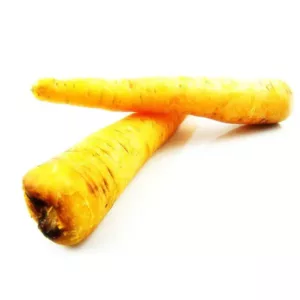Cooking parsnip can be done in many ways, such as roasting, boiling and pureeing. No matter which method you choose, we have cooking times and cooking temperatures for you! Parsnips are a type of root vegetable that look similar to carrots but have a sweeter flavor. Translation in French: panais.

Parsnips
How do I cook parsnips?
- Preparing parsnips
- Cooking parsnip in an oven (roasted)
- Cooking parsnip in a pot (in water)
- Cooking mashed parsnip (pureed)
What to pair parsnips with?
Parsnips can be paired with carrots or potatoes. They make a nice side dish for a meal with pork roast or roast beef.
Preparing parsnips
Preparing parsnips is very similar to preparing carrots: Cut off the leaves (if available), then simply wash them under running water, then peel them (with a vegetable peeler). Discard the hardened part next to the leaves and dice the parsnips, slice them or cut them in sticks (it’s called a julienne).
Cooking parsnip in an oven
Cooking parsnip in an oven. To roast parsnips:
1. Preheat the oven at 400°F (200°C)
2. Peel, chop, and toss the parsnips with olive oil, salt, and pepper.
3. Roast for 20-30 minutes, or until golden brown and tender.
Cooking parsnips in a pot
Cooking parsnips in a pot. Another popular cooking method is boiling parsnips:
1. Bring salted water to a boil.
2. Add the diced parsnips. Cook for 15 to 20 minutes (For whole parsnips, cook for 20 to 30 minutes)
Cooking pureed parsnips
Pureeing parsnips helps you cook a great side dish.
1. Bring salted water to a boil.
2. Add the cubed parsnips. Cook for 15 to 20 minutes until soft.
3. Then mash or puree. If the consistency is too thick, add a bit of the cooking water.
Parsnips are a good source of fiber, vitamins, and minerals, and are often used in winter recipes due to their seasonal availability.
Vegetables are an essential part of a healthy diet. They offer a wide range of nutrients that are essential for maintaining good health. They contain lots of vitamins, minerals, and antioxidants that can help to prevent a number of chronic diseases.
Fiber helps to keep your digestive system functioning properly and can also help to lower cholesterol levels and reduce the risk of heart disease.
Vegetables are low in calories and high in fiber, which can help to promote weight loss and maintain a healthy weight. Eating a diet rich in vegetables can also improve digestion and gut health, as the fiber in vegetables helps to promote regular bowel movements and maintain a healthy balance of gut bacteria.
No matter which vegetables you choose to include in your diet, it’s important to aim for a variety of different types in order to get the full range of nutrients. Whether you enjoy them raw, cooked, or as part of a recipe, vegetables should be an important part of your daily eating routine. By incorporating more vegetables into your diet, you can help to improve your overall health. Cooking-times.com can help you! Just follow our guidelines and start cooking!
